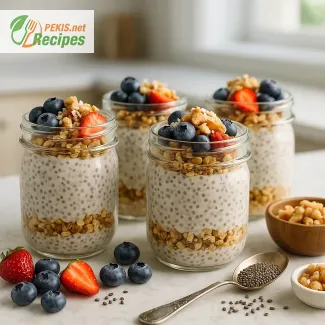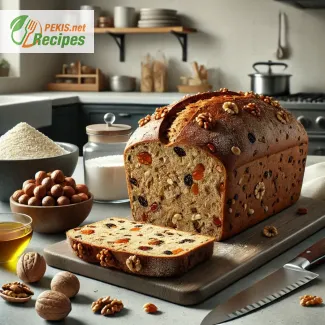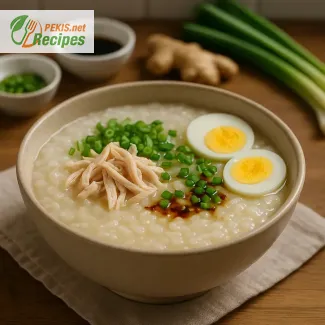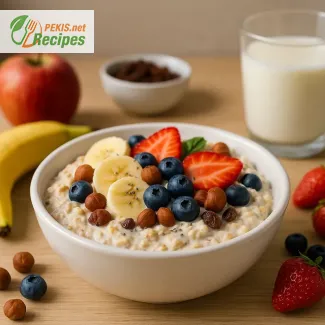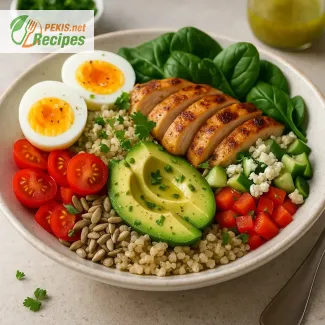
Protein Pancakes: A Deliciously Nutritious Powerhouse. Protein pancakes have soared in popularity as a balanced, protein-packed alternative to traditional pancakes. Designed to satisfy cravings for something sweet and fluffy while supporting fitness and wellness goals, protein pancakes are a versatile addition to any diet. Made with ingredients rich in protein, these pancakes help maintain muscle, fuel workouts, and keep hunger at bay. They’re loved by fitness enthusiasts, athletes, and health-conscious eaters alike. Let's dive deeper into what protein pancakes are, how they’re beneficial, and the various types available to suit every taste and dietary need.
What Are Protein Pancakes?
Protein pancakes differ from regular pancakes in that they have a higher protein content, usually achieved through protein-rich ingredients like protein powder, Greek yogurt, or cottage cheese. Protein is essential for muscle repair, energy, and satiety, making protein pancakes a valuable meal for individuals looking to maintain a high-protein diet, either for fitness, weight loss, or overall wellness.
Typically, a serving of protein pancakes offers around 20–30 grams of protein, depending on the recipe. This is significantly higher than regular pancakes, which often provide less than 10 grams of protein per serving. Additionally, protein pancakes can be made with healthier flours such as whole wheat, oat, or almond flour, which contribute fiber and complex carbohydrates. These healthier ingredients improve digestion, stabilize blood sugar levels, and provide sustained energy, ideal for starting the day strong or refueling post-workout.
Health Benefits of Protein Pancakes
The advantages of protein pancakes go beyond muscle repair and recovery. Here are some key benefits:
- Muscle Building and Recovery: Protein is vital for muscle growth and repair. Eating protein pancakes, particularly after exercise, can help the body rebuild muscle fibers, aiding in quicker recovery.
- Increased Satiety: Protein has a high satiety factor, meaning it keeps you feeling full longer. Protein pancakes can reduce the urge to snack between meals and support weight management by curbing cravings.
- Enhanced Metabolism: The thermic effect of food (TEF) is higher for protein than for fats or carbs, meaning protein pancakes can help increase metabolism.
- Balanced Blood Sugar Levels: The fiber and protein content in protein pancakes help stabilize blood glucose, reducing energy crashes that can happen with regular pancakes that are high in simple carbohydrates.
- Versatile and Customizable: Whether you prefer classic flavors or something unique, protein pancakes are adaptable to various dietary needs, from gluten-free to vegan or low-carb.
Types of Protein Pancakes
Protein pancakes come in many variations, allowing for a perfect fit for every dietary preference and nutritional goal. Here’s a look at some popular types:
1. Whey Protein Pancakes
Whey protein is a fast-digesting, complete protein containing all essential amino acids, making it ideal for post-workout meals. Whey protein pancakes are fluffy and offer a great taste, often reminiscent of traditional pancakes. They are especially suitable for those looking for quick muscle recovery and enhanced amino acid intake. Popular flavors for whey protein pancakes include vanilla, chocolate, and berry.
2. Casein Protein Pancakes
Casein protein is a slow-digesting protein, releasing amino acids over several hours. Casein protein pancakes are ideal for a long-lasting source of energy and are often enjoyed as a pre-bedtime snack. The texture is usually thicker, and these pancakes are especially filling. Casein protein pancakes can be flavored with cocoa, cinnamon, or even pumpkin spice for a richer, denser pancake.
3. Plant-Based Protein Pancakes
Plant-based protein pancakes use protein powders derived from sources like pea, rice, hemp, or chia seeds, making them suitable for vegans and vegetarians. These pancakes are often slightly denser than those made with whey but still deliver excellent flavor and texture. Ideal for anyone with dairy intolerance or following a vegan diet, plant-based protein pancakes can be flavored with bananas, blueberries, or nuts for added taste and texture.
4. Egg White Protein Pancakes
Egg whites are a low-fat, complete protein source, making them a lean option for protein pancakes. Egg white protein pancakes are fluffy and light, offering a similar taste to traditional pancakes but with higher protein content. These pancakes can be paired with fresh fruits, yogurt, or almond butter for a balanced and satisfying meal.
5. Cottage Cheese or Greek Yogurt Pancakes
Using cottage cheese or Greek yogurt adds natural protein and a creamy texture to the batter. These ingredients are rich in probiotics, contributing to digestive health. Pancakes made with Greek yogurt or cottage cheese tend to be thicker and are often paired with fruits or a drizzle of honey for natural sweetness.
6. Gluten-Free Protein Pancakes
For those with gluten intolerance, gluten-free protein pancakes can be made using gluten-free oats, almond flour, or coconut flour. These pancakes are usually paired with a protein powder that is also gluten-free. Gluten-free protein pancakes provide the same benefits as other protein pancakes while accommodating dietary restrictions.
Flavors and Additions
One of the best things about protein pancakes is their versatility. They can be enjoyed in various flavors and enhanced with delicious add-ins, such as:
- Fruits: Bananas, blueberries, and strawberries not only add natural sweetness but also supply fiber and antioxidants.
- Spices: Cinnamon, nutmeg, and vanilla extract are popular options for enhancing flavor.
- Nut Butters and Seeds: Adding almond butter, chia seeds, or flaxseeds increases the healthy fats and adds a satisfying crunch.
- Chocolate or Cocoa Powder: For a decadent touch, a scoop of cocoa powder or chocolate chips can turn protein pancakes into a healthy indulgence.
Tips for Making Perfect Protein Pancakes
Protein pancakes are easy to make, but a few tips can help achieve the perfect texture:
- Use a Combination of Flours: Blending oat flour or almond flour with protein powder creates a better texture, making the pancakes fluffier and less dense.
- Adjust Liquid Content: Protein powders can vary in absorption, so adjusting the amount of milk or water can help reach the ideal pancake batter consistency.
- Avoid Overmixing: Overmixing can lead to dense, chewy pancakes. Gently folding the ingredients keeps the pancakes light and airy.
- Cook on Medium Heat: High heat may cause protein pancakes to burn quickly, so cooking on medium heat ensures they cook evenly without over-browning.
- Use Non-Stick Spray or Coconut Oil: Protein pancakes tend to stick more than regular pancakes, so a bit of non-stick spray or coconut oil helps achieve a clean flip and a golden finish.
How to Incorporate Protein Pancakes Into Your Diet
Protein pancakes are incredibly versatile and can be enjoyed at any time of day:
- Breakfast: A filling breakfast option, protein pancakes paired with fruit or yogurt set a healthy tone for the day.
- Post-Workout: After exercise, protein pancakes offer an ideal combination of protein and carbohydrates, helping replenish glycogen stores and repair muscles.
- Snack: Enjoy a smaller portion of protein pancakes as a healthy snack, especially with a bit of almond butter or fresh fruit for a boost of healthy fats and fiber.
Protein pancakes are a delicious, nutritious way to meet protein goals without sacrificing taste. With so many variations, they cater to diverse dietary needs and preferences, from whey-based options to plant-based and gluten-free varieties. Adding protein pancakes to your diet can help achieve fitness goals, maintain energy levels, and indulge in a satisfying meal without the usual sugar and refined carbs found in traditional pancakes.
- Grind the oats: Start by grinding the oats into a fine flour using a blender or food processor, if they aren’t already ground. This will create a smoother pancake batter.
- Combine dry ingredients: In a medium mixing bowl, add the oat flour, protein powder, baking powder, cinnamon, and salt. Whisk to ensure all dry ingredients are well-mixed.
- Mix wet ingredients: In a separate bowl, whisk together the milk, egg, vanilla extract, and honey or maple syrup if using. Whisk until smooth and well-blended.
- Combine wet and dry ingredients: Pour the wet ingredients into the bowl with the dry ingredients. Mix gently until you have a smooth, thick batter. If the batter is too thick, add a bit more milk to reach a pancake-like consistency.
- Preheat the pan: Heat a non-stick skillet over medium heat. Lightly grease it with a small amount of oil or cooking spray.
- Cook the pancakes: Pour about 60 ml (approx. 2 fl oz or 1/4 cup) of batter onto the skillet for each pancake. Cook for about 2-3 minutes until bubbles form on the surface and the edges begin to firm up. Flip and cook the other side for an additional 2-3 minutes or until golden brown.
- Serve: Serve warm with your favorite toppings, such as fresh berries, Greek yogurt, nuts, or a drizzle of honey.
Enjoy these protein pancakes as a satisfying and nutritious meal that’s perfect for a post-workout recovery or a protein-boosted start to your day!
Nutritional Benefits and Health Impact of Protein Pancakes
Protein pancakes are not only a tasty meal but also pack numerous health benefits due to their balanced nutrient profile. By combining protein-rich ingredients with complex carbohydrates, they offer a powerful source of sustained energy and nutrients essential for various bodily functions. Below, we break down the health impact of the primary nutrients and ingredients in protein pancakes, highlighting the specific ways they support our health.
Macronutrients and Their Benefits
- Proteins (23 g per serving)
- Protein is essential for the growth, repair, and maintenance of body tissues. It helps maintain muscle mass and supports recovery, especially beneficial after physical activity.
- Proteins in this recipe come from both the protein powder and the egg, providing complete protein sources with all essential amino acids. These are particularly beneficial for muscle repair and immune function.
- Protein powder also enhances satiety, meaning it can help control appetite by keeping you full longer, supporting weight management and reducing the urge to snack between meals.
- Carbohydrates (35 g per serving)
- Carbohydrates in the recipe are primarily from oats and milk, both of which provide complex carbs that are slow-digesting. This helps to stabilize blood sugar levels, reducing energy crashes often associated with refined carbs.
- Oats are a whole grain rich in fiber, which improves digestion and provides a steady energy release, ideal for active individuals and anyone needing sustained focus throughout the day.
- The fiber in oats also helps reduce LDL cholesterol levels, supporting cardiovascular health.
- Fats (8 g per serving; 2 g saturated, 6 g unsaturated)
- Fats are vital for brain health, hormone regulation, and absorption of fat-soluble vitamins (A, D, E, and K).
- The recipe keeps fats in balance, with a higher proportion of unsaturated fats, primarily from ingredients like milk and optional almond flour, which are heart-healthy and help manage inflammation.
- Saturated fats are minimal, ensuring that these pancakes are not detrimental to heart health, especially when enjoyed as part of a balanced diet.
Key Vitamins and Their Impact
- Vitamin B Complex (notably B1, B2, B3, and B6)
- Oats and eggs are rich in B vitamins, which play a key role in energy metabolism and support cognitive health. Specifically, B6 (pyridoxine) aids in neurotransmitter function, which can impact mood and cognitive clarity.
- B vitamins also support the nervous system and are involved in red blood cell formation, essential for oxygen transport throughout the body.
- Vitamin E
- Oats contain Vitamin E, a powerful antioxidant that helps protect cells from oxidative stress and supports skin and immune health.
- Vitamin E is also beneficial for heart health, as it helps prevent oxidation of cholesterol, which can protect against atherosclerosis (plaque buildup in arteries).
- Vitamin A (from eggs)
- Eggs in the recipe are a source of Vitamin A, which is crucial for eye health, immune function, and cellular growth. Vitamin A supports vision by maintaining the health of the retina, especially in low-light conditions.
- It also supports skin health and is essential in wound healing, making it valuable for both external and internal cellular regeneration.
- Vitamin D (if fortified milk is used)
- Milk, if fortified, provides Vitamin D, which is critical for bone health and immune function. Vitamin D enables calcium absorption in the bones, supporting skeletal integrity and helping prevent conditions like osteoporosis.
Minerals and Their Benefits
- Calcium (from milk and oats)
- Milk is a primary source of calcium, which is essential for bone density and muscle function. This mineral works closely with Vitamin D to ensure healthy bones and teeth.
- Calcium also plays a role in muscle contraction and nerve transmission, making it essential for athletic performance and day-to-day activities.
- Iron (from oats and eggs)
- Iron supports oxygen transport in the bloodstream, as it is a key component of hemoglobin in red blood cells. This is especially beneficial for maintaining energy levels, preventing fatigue, and supporting cellular function.
- Including iron-rich foods like oats and eggs is crucial for everyone, particularly those with higher iron needs, such as athletes, menstruating women, and children.
- Magnesium (from oats)
- Magnesium is a vital mineral that assists in muscle relaxation, energy production, and regulation of blood pressure.
- Oats are a great source of magnesium, contributing to the maintenance of a calm nervous system and supporting recovery post-exercise by reducing muscle tension and cramps.
- Phosphorus (from oats and eggs)
- This mineral is involved in bone health and energy production through ATP (adenosine triphosphate), which stores and releases energy as needed by cells.
- Phosphorus also aids in maintaining the body’s acid-base balance, which is essential for various biochemical processes.
- Zinc (from oats and eggs)
- Zinc supports immune function and cellular repair. It plays a significant role in DNA synthesis and cell division, promoting skin health and wound healing.
- Zinc also acts as an antioxidant, helping protect cells from oxidative damage.
Dietary Fiber (5 g per serving)
- Oats provide soluble fiber in the form of beta-glucan, which helps improve heart health by lowering LDL cholesterol and aids in stabilizing blood sugar levels.
- Fiber contributes to digestive health by promoting regular bowel movements and supporting gut bacteria, which play a role in overall immunity and nutrient absorption.
Health Tips and Recommendations
For individuals with allergies, simple substitutions can help make these protein pancakes accessible to everyone:
- Egg Allergy: Replace the egg with a chia or flaxseed “egg” (1 tbsp ground seeds mixed with 3 tbsp water). This maintains the pancake’s structure while adding extra fiber and omega-3 fatty acids.
- Dairy Allergy: Opt for plant-based milks such as almond, oat, or soy milk, which are low in saturated fat and can be fortified with vitamins and minerals. Plant-based milks like almond milk also offer vitamin E, further boosting antioxidant intake.
- Gluten Sensitivity: Use certified gluten-free oats or replace oat flour with almond flour or buckwheat flour, both of which are gluten-free and offer additional fiber and minerals.
By combining these nutrient-dense ingredients, protein pancakes become a powerful meal for muscle recovery, sustained energy, and overall health support. This recipe is not only delicious but also provides a balanced nutritional profile that fits well into a healthy lifestyle and supports both physical and mental well-being.
Incorporating Protein Pancakes into Your Diet: Frequency and Tips
Protein pancakes are a versatile and nutritious option, suitable for individuals aiming to increase their protein intake while enjoying a satisfying meal. As part of a balanced diet, these pancakes can be included 2–3 times per week as a breakfast option, post-workout meal, or satisfying snack. Their high protein content, combined with fiber and complex carbohydrates, makes them especially beneficial for muscle recovery, sustained energy, and appetite control. For those with active lifestyles or specific fitness goals, incorporating protein pancakes can support both muscle maintenance and weight management by promoting fullness and reducing cravings.
General Tips for Enjoying Protein Pancakes
- Balance with Other Meals: To maximize their health benefits, pair protein pancakes with meals rich in leafy greens, colorful vegetables, and healthy fats throughout the day. This variety supports a balanced intake of essential nutrients.
- Vary the Protein Source: While whey or plant-based protein powders are popular, feel free to experiment with cottage cheese, Greek yogurt, or eggs to diversify protein sources. Different proteins add unique amino acid profiles and textures, contributing to the recipe’s versatility.
- Boost with Fiber-Rich Additions: Add fruits like bananas, berries, or apples to increase fiber and vitamin intake. These fruits bring natural sweetness and antioxidants, which further enhance the nutritional profile of the pancakes.
- Limit Sugary Toppings: To maintain the health benefits of this meal, choose toppings that are nutrient-dense rather than high in refined sugars. Fresh fruits, a dollop of Greek yogurt, or a drizzle of honey provide sweetness without compromising nutritional integrity.
- Consider Portion Control: For weight management, pay attention to portion sizes and avoid overindulging. Protein pancakes are filling, and a standard serving should satisfy hunger while leaving room for other nutrient-rich foods throughout the day.
In summary, protein pancakes are a beneficial addition to a balanced diet, especially when enjoyed in moderation and paired with a variety of nutrient-dense foods. Regularly including this meal can help meet daily protein needs, support active lifestyles, and promote overall well-being.
Egg: Present in the recipe.
- Substitution: Replace with 1 tbsp chia seeds or flaxseeds mixed with 3 tbsp water (let sit for 5 minutes).
Dairy (if using dairy milk):
- Substitution: Use plant-based milk alternatives like almond, soy, or oat milk.
Gluten (if oats are not certified gluten-free):
- Substitution: Use certified gluten-free oats or replace oat flour with almond flour or buckwheat flour.
